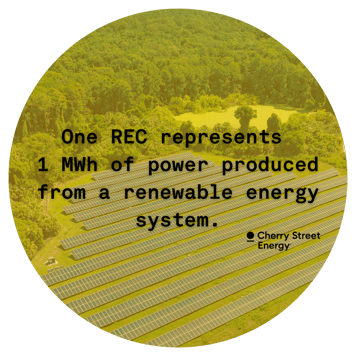Renewable Energy Credits and Emission Offset
More and more, companies and organizations are setting ESG goals. The path to delivering on those stated goals may not always be clear. "Simple Sustainability" is a series meant to help demystify that path, and equip sustainability leaders and others with the knowledge to achieve sustainability goals. Today's focus is renewable energy credits (RECs).
In today’s environmentally conscious business landscape, companies often look to renewable energy credits (REC) to help them achieve their sustainability goals. But what is a REC exactly? And are they the right call for your net-zero strategy? Let’s break down the essentials of RECs and explore their role in corporate sustainability strategies. Companies with stated emissions reduction goals often use RECs to address those goals.

What Are Renewable Energy Credits?
A Renewable Energy Credit (REC) is a market-based instrument that represents the environmental benefits of one megawatt-hour (MWh) of electricity generated from renewable sources like solar, wind, or hydropower.
When renewable energy is produced, it creates two products: the electricity itself and the associated environmental attributes (RECs), e.g. that it is carbon free. While the electricity flows into the grid, RECs can be sold separately. RECs can be traded in voluntary or compliance markets, with prices varying based on supply, demand, and renewable energy resource type. By purchasing RECs, organizations can claim the environmental benefits of renewable energy without directly generating it themselves.
A key benefit of RECs is that they provide financial support for renewable energy projects, helping to drive the transition to cleaner energy sources.
How Are Renewable Energy Credits Purchased?
RECs can be bought through:
- Direct contracts with renewable energy generators.
- Third-party REC marketers or brokers.
- Utilities offering green power programs.
- REC tracking systems in various regions.
Companies can purchase RECs to match their electricity consumption or to meet specific sustainability targets. Once a company has purchased a REC, it can now legally claim the renewable energy production that the certificate represents. RECs purchased in compliance markets (i.e. those having a Renewable Portfolio Standard or other legal requirement that electricity come from a certain percentage of renewable sources) tend to be more expensive.
RECs don’t last forever. They have expiration dates (also known as retirement dates). These dates vary by region, but most RECs have a tradeable window of 21 months before retirement. The retirement date is stated on the REC and, once it date occurs, the REC can no longer be included in emissions reduction reporting. Once a REC is retired, it cannot be sold or traded again. The “end user” becomes the only entity that can legally claim the associated renewable energy production.

How Are Renewable Energy Credits Verified?
To ensure integrity, RECs are typically verified by independent third-party organizations. These verifiers track RECs from generation to retirement, ensuring each REC is only claimed once. Reputable certification systems, such as Green-e in North America, provide additional assurance of REC quality and validity.
Are Renewable Energy Credits Right for a Business’s Sustainability Goals?
RECs can be a useful tool in a corporate sustainability strategy, but they come with both advantages and limitations. By understanding the nuances of RECs, businesses can make informed decisions about their role in achieving sustainability targets.
Advantages
- Immediate impact: RECs allow businesses to quickly claim renewable energy use without investing in physical infrastructure.
- Flexibility: Companies can purchase RECs regardless of their location or ability to generate renewable energy on-site.
- Scalability: Companies can easily adjust their REC purchases to match changing energy needs or goals.
- Support for Renewable Energy: REC purchases provide financial support to renewable energy projects, indirectly contributing to grid decarbonization.
- Compliance: in markets with renewable energy mandates, RECs can help meet regulatory requirements.
Limitations
- Additional concerns: REC purchases may not always lead to new renewable energy development, especially in saturated markets.
- Price volatility: REC prices can fluctuate, making long-term budgeting a challenge.
- Perception issues: Some view REC purchases as less impactful than direct renewable energy investments.
- Limited long-term benefits: Unlike energy efficiency investments or on-site generation, RECs typically don’t reduce long-term energy costs.
- Complexity: The REC market can be complex, requiring careful verification to ensure quality and avoid double-counting.
Given their limitations, companies should consider RECs as a part of a comprehensive sustainability strategy, not as a sole solution. For optimal results, companies should combine REC purchases with energy efficiency measures and direct renewable energy investments. For example, companies should consider power purchase agreements (PPAs), which in Georgia may be referred to as solar energy procurement agreements (SEPAs), as a way of directly supporting and benefiting from on-site renewable energy projects.
Under a PPA or SEPA, companies work with a third-party provider (like Cherry Street!) who will build and operate the project at no upfront cost. The provider charges only for the renewable energy delivered by the project at a rate that is competitive, predictable and that helps hedge against rising electricity costs. RECs are typically included in the agreement at no additional cost. Companies entering PPAs or SEPAs should retain and retire the associated RECs so that they can fully claim the renewable energy use and count it towards sustainability goals.
In summary, while REC purchases can be a good way for businesses to meet short-term sustainability goals or supplement other efforts, they are most effective when used as part of a broader, long-term sustainability strategy that includes direct actions to reduce energy consumption and increase renewable energy use.



